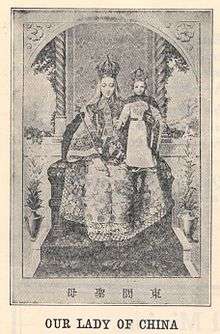Our Lady of China
Our Lady of China (Simplified Chinese: 中华圣母, Traditional Chinese: 中華聖母, pinyin: Zhōnghuá Shèngmǔ) is the name given to an apparition of the Blessed Virgin Mary in Donglu, China, first appearing in 1900.

History
At the close of the 1924 Shanghai Synod of Bishops in China, the first national conference of bishops in the country, Archbishop Celso Costantini (剛恆毅), Apostolic Delegate in China, along with all the bishops of China, consecrated the Chinese people to the Blessed Virgin Mary. In 1941, Pope Pius XII designated the feast day as an official feast of the Catholic liturgical calendar.[1]
In 1973, following the Second Vatican Council, the Chinese Bishops conference, upon approval from the Holy See, placed the feast day on the vigil (day preceding) of Mothers Day (the second Sunday of May).[1]
The Apparition
During the Boxer Rebellion, a great number of soldiers attacked the village of Donglu, Hebei. The village consisted of a small community of Christians founded by the Vincentian Fathers. The Virgin Mary appeared in white, and a fiery horseman (believed to be St Michael) chased away the soldiers. The pastor, Fr Wu, commissioned a painting of Mary with Christ child dressed in golden imperial robes. This painting became the image of Our Lady, Queen of China. Donglu became a place of pilgrimage in 1924. The image was blessed and promulgated by Pope Pius XI in 1928.[2]
Veneration
There is a mosaic of Our Lady of China in the Basilica of the National Shrine of the Immaculate Conception in Washington, D.C., established and dedicated in 2002 under the Most Rev. Michael J. Bransfield [3] There has been some controversy because the image used in the mosaic is not the officially approved image of Our Lady of China, but instead uses the image of Our Lady of China and Baby Jesus painted by John Lu Hung Nien. The late Cardinal Thomas Tien Keng-Hsin, the first Chinese Cardinal, used this image for the prayer card for the persecuted in China, which was widely promoted in the U.S.A. and Canada.[4]
Several churches, chapels, and pastoral centers around the world, predominantly those focused on ministry to Chinese-speaking Catholics, have adopted the name, including a mission in Washington, D.C. St. Genevieve's Chinese Roman Catholic Church, Fresno, California also honors Our Lady of China. There is a Chapel of Our Lady of China in the Diocese of Brooklyn, New York.[5]
In the Philippines where the Chinese and Chinese-Filipinos comprise the biggest ethnic community, the Santa Maria Parish of the Jesuit Fathers, located at the old Ateneo campus in Iloilo City, is the only church in the country dedicated to Our Lady of China that is duly recognized by the Catholic Bishops Conference of the Philippines (CBCP). The Archdiocesan Shrine of the Most Sacred Heart of Jesus in D. Jakosalem, Cebu City, still by the Jesuits, also houses an image of Our Lady of China. It used to be dedicated to this title of Our Lady until the patronage was changed to the Sacred Heart of Jesus. Although Binondo in Manila is the country's Chinese capital, both the Minor Basilica of Saint Lorenzo Ruiz (Filipino Parish) and the Binondo Chinese Parish does not house an image of the Chinese Madonna (as clarified by representatives of both parishes). As of April 2015, images of Our Lady of China (sometimes referred to as Our Lady of Sheshan) can be found at the following Chinese-Filipino Catholic communities: Santa Maria Parish-Our Lady of China, Iloilo City; Archdiocesan Shrine of the Most Sacred Heart of Jesus, Cebu City; Saint Peter the Apostle Parish, Paco, Manila; Lorenzo Ruiz Mission Society Seminary, Manila; Saint Jude Catholic School (National Shrine of Saint Jude Thaddeus), Manila and Queen of Peace Parish, Bacolod City and Our Lady of Lourdes Parish in Butuan City (P. Burgos Street).
The Our Lady of Sheshan is another, similar apparition which has attained like acclamation and fame among Chinese Christians.
References
Citations
- "Our Lady of China", The Cardinal Kung Foundation
- "Our Lady, Queen of China", St Dominic's Priory, Macau
- Basilica of the National Shrine of the Immaculate conception
- ""Our Lady of China", The Marian Library, University of Dayton". Archived from the original on 2013-07-30. Retrieved 2014-08-17.
- R.C. Our Lady of China Chapel